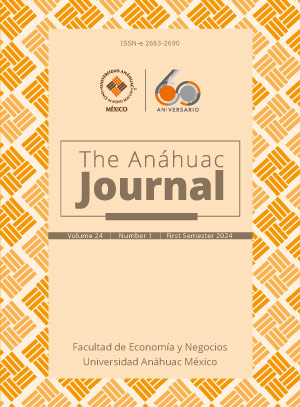Grandes exposiciones: add-ons por concentración de riesgo de crédito implícita y el marco de Basilea
Contenido principal del artículo
Resumen
La regulación de Basilea sobre grandes exposiciones está en proceso de implementación y, aunque es una regulación que reduce el límite del tamaño para las exposiciones de gran tamaño en los bancos y está orientada a un mejor control de los parámetros de riesgo que ocasiona que los portafolios se inclinen más a tener pérdidas grandes por concentración de crédito, es importante conocer la porción de riesgo de crédito y capital que lleva implícita. En este trabajo se determinan, mediante una simulación Montecarlo a través de un modelo de riesgo de crédito, los add-ons implícitos (o añadidos implícitos) debidos a la concentración de crédito, y se comparan con los requisitos actuales de capital. Al mismo tiempo, se analiza el marco completo de Basilea para entender cómo se aborda el riesgo de crédito de concentración, esto es, de forma integral, más que mediante un suplemento particular de capital
Downloads
Detalles del artículo
Sección

Esta obra está bajo una licencia internacional Creative Commons Atribución-NoComercial-CompartirIgual 4.0.
The Anáhuac Journal se distribuye bajo Licencia Creative Commons Atribución-NoComercial-CompartirIgual 4.0 Internacional.
Cómo citar
Referencias
Artzner, P., Delbaen, F., Eber, J. & Heath, D. (1999). Coherent measures of risk. Mathematical Finance, (9)3, 203–228. https://doi.org/10.1111/1467-9965.00068 DOI: https://doi.org/10.1111/1467-9965.00068
Banco de México. (2023). Reporte de estabilidad financiera: segundo semestre 2023. https://www.banxico.org.mx/publicaciones-y-prensa/reportes-sobre-el-sistemafinanciero/%7B6B881BAE-59D7-05D2-0B38-1E72528030BA%7D.pdf
Basel Committee on Banking Supervision (BCBS). (2004). International convergence of capital measurement and capital standards: A revised framework. Bank for International Settlements. https://www.bis.org/publ/bcbs107.htm
Basel Committee on Banking Supervision (BCBS). (2005). Selected literature on concentration risk in credit portfolios. Bank for International Settlements. https://www.bis.org/bcbs/events/rtf05biblio.htm
Basel Committee on Banking Supervision (BCBS). (2006). Studies on credit risk concentration:An overview of the issues and a synopsis of the results from the Research Task Force project. (Working Paper No. 15). Bank for International Settlements. https://www.bis.org/publ/bcbs_wp15.htm
Basel Committee on Banking Supervision (BCBS). (2009). Strengthening the resilience of the banking sector. Bank for International Settlements. https://www.bis.org/publ/bcbs164.htm
Basel Committee on Banking (BCBS). (2023). Regulatory Consistency Assessment Programme (RCAP). Assessment of Basel large exposures regulations – Mexico. https://www.bis.org/bcbs/publ/d564.htm
Comisión Nacional Bancaria y de Valores. (CNBV). (2023). Manual para la elaboración de la evaluación de suficiencia de capital bajo escenarios supervisores e internos 2023-2025. https://portafolioinfo.cnbv.gob.mx/PortafolioInformacion/Manual_BM.pdf
Comisión Nacional Bancaria y de Valores. (CNBV). (2024a). Disposiciones de carácter general aplicables a las instituciones de crédito. https://shorturl.at/aIMS1
Comisión Nacional Bancaria y de Valores. (CNBV). (2024b). Bancos de Importancia Sistémica Local. https://www.gob.mx/cnbv/acciones-y-programas/bancos-de-importancia-sistemica
Comisión Nacional Bancaria y de Valores. (CNBV). (2024c). Portafolio de Información. https://portafolioinfo.cnbv.gob.mx/Paginas/Inicio.aspx
Consejo de Estabilidad del Sistema Financiero. (2018–2024). Informe anual sobre el estado que guarda la estabilidad del sistema financiero en México y sobre las activi dades realizadas por el Consejo de Estabilidad del Sistema Financiero. https://www.cesf.gob.mx/en/CESF/Publicaciones_e_informes
Financial Stability Institute. (FSI). (2019). The capital buffers in Basel III: Executive summary. Bank for International Settlements. https://www.bis.org/fsi/fsisummaries/b3_capital.htm
Financial Stability Institute (FSI). (2022). Large exposures standard: Executive summary. Bank for International Settlements. https://www.bis.org/fsi/fsisummaries/lex.pdf
Gordy, M. (2003). A risk-factor model foundation for ratings-based bank capital rules. Journal of Financial Intermediation, 12(3), 199-232. https://doi.org/10.1016/S1042-9573(03)00040-8 DOI: https://doi.org/10.1016/S1042-9573(03)00040-8
Gordy, B. & Lutkebohmert, E. (2013). Granularity Adjustment for Regulatory Capital Assessment. International Journal of Central Banking, 9(3), 33-71. https://www.ijcb.org/journal/ijcb13q3a2.pdf
Hibbeln, M. (2010). Risk Management in Credit Portfolios: Concentrations Risk and Basel II. (Contributions to Economics). Physica Heidelberg. https://doi.org/10.1007/978-3-7908-2607-4 DOI: https://doi.org/10.1007/978-3-7908-2607-4
JP Morgan & Reuters. (eds.) (1996). RiskMetrics-Technical Document. Morgan Guaranty Trust Company of New York. https://www.msci.com/documents/10199/5915b101-4206-4ba0-aee2-3449d5c7e95a
Márquez Diaz-Canedo, J. (2003). Suficiencia de capital y riesgo de crédito en portafolios de préstamos bancarios. In Elizondo, A. (Ed.). Medición integral del riesgo de crédito. Limusa. DOI: https://doi.org/10.36095/banxico/di.2002.04
Nokkala, Jan. (2022). Are large credit exposures a source of concentration risk? Bank i Kredyt, 53 (4), 375-398. https://bankikredyt.nbp.pl/content/2022/04/BIK_04_2022_02.pdf
Relim, T., Mariano, A., Monteiro, S., Grubisic, V. & Oliveira, E. (2019). Credit Risk Concentration in the Banking Industry: A Systematic Literature Review. 34th IBIMA Conference, November 13–14, Madrid. https://www.researchgate.net/publication/339314572_Credit_Risk_Concentration_in_the_Banking_Industry_A_Systematic_Literature_Review
Venegas Martínez, F. (2008). Riesgos financieros y económicos. Cengage Learning. Wilde, T. (2001a). The IRB approach explained. Risk Magazine, 14(5), 87-90. https://www.risk.net/infrastructure/1530304/irbapproach-explained
Wilde, T. (2001b). Probing granularity. Risk Magazine, 14(8), 103-106. https://www.risk.net/infrastructure/1530360/probing-granularity
World Bank. (n.d.). Global Financial Development Database. (DataBank) https://shorturl.at/aflPT
Yi Xiao, J. & Finger, C. (2002). Treatment of Retail and Small Business Exposures. (Risk-Metrics Group Product Technical Note). RiskMetrics Group.

